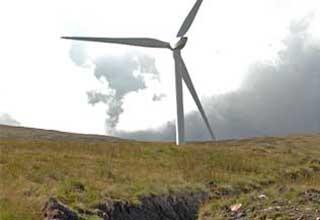Renewable Energy and Water Resource Inter-relations
Published on 7 March 2013 in Climate, water and energy

Introduction
Sustainable economic growth for Scotland is dependent on supplies of key resources such as food, water and energy. Under the Scottish Government’s 2020 Routemap for Renewable Energy, Scotland is committed to achieving substantial increases in the proportion of energy from renewable sources. Increases in land based renewables will lead to associated changes in land use and infrastructural developments. Although Scotland is generally considered to have adequate water resources of good quality, these resources are unevenly distributed and are currently subject to a range of pressures. This briefing outlines some of the key inter-relations between water and energy and highlights some issues that need to be considered in implementation of policies for renewable energy.
Key Points
Impact of land use on water quantity
The 2020 Routemap for Renewable Energy and the Land Use Strategy for Scotland promote plans for new forestry to be planted. Some areas have recently been planted with willow, a fast growing tree species suitable for biomass production. Willow has a very high water usage which could cause a net decrease in the amount of runoff reaching surface and groundwater bodies but could also have positive benefits for natural flood management, if suitably located. Other energy crops, such as miscanthus, also have a relatively high water demand which could increase the demand for irrigation water in some areas.
Impact of land use on water quality
Energy crops such as willow and miscanthus also require addition of agricultural fertilisers which are the primary source of diffuse pollution of Scotland’s waters by N and P. An increased usage could be detrimental for water quality. Recent studies have indicated that willow can uptake very high levels of nutrients in conjunction with its high water usage and is therefore unlikely to lead to increases in pollution. Indeed, willow plantations are presently being trialled as a method of purification at small sewage treatment works.
Hydro scheme impacts
Existing hydro schemes account for a significant proportion of Scotland’s renewable energy output, contributing around 10% of total current energy generated. They are also the most significant cause of water abstraction and flow regulation impacts on Scottish waters. Principal environmental concerns relate to their impact on fish populations, including obstructing migratory routes, pollution associated with construction, inter-catchment transfers and changes in hydrology. However, well managed projects can have a net benefit on water quality through increased oxygenation. In the context of micro hydro schemes, the proliferation of multiple schemes on the same river system is a potential cause for concern.
Wind farm construction impacts on water quality
Recent land-based renewable energy developments have seen construction of a large number of both individual wind turbines and larger scale wind farms. Whilst the technology itself should not cause any direct impacts on the water environment, construction of the sites can impact on aspects such as increased sediment and dissolved organic carbon resulting from construction work and site drainage. Windfarm construction in upland regions may exacerbate losses of C from peatlands and is of concern to fisheries in otherwise pristine catchments.
Water supply and energy usage
Supply and treatment of drinking and waste water have high energy demands. Scottish Water had a total energy consumption of 440GWh in 2010/11, which has decreased by around 7% since 2007/08 due to a concerted program of energy savings. Future demand for water is expected to increase against a decreasing availability of supply of water. This may necessitate an increased transfer of water, leading to a higher energy demand despite efficiency savings. Increased use of renewable energy sources can be used to mitigate against this change, for example through the use of wind power to fill the pump storage reservoirs.
Research Undertaken
A programme of research is being undertaken to evaluate the significance of the inter-relationships between water and renewable energy. Three main methods are being used in the analysis.
Spatial evaluation
A geo-database of environmental characteristics that may have an influence or relevance to the suitability of different land areas for contrasting types of renewable energy is being constructed. A tool for assessing the land capability for wind turbines (Figure 1, see related documents) is being enhanced to integrate spatial information about water resource characteristics. Land capability is also being used as a key dataset for developing likely future scenarios for land use, linked to renewable energy developments.
Modelling
We have developed a water balance model for Scotland that allows the distribution of water resources to be simulated under both current conditions and for future scenarios of land use and climate. We have also developed a spatial risk assessment modelling methodology for exploring how different land uses will impact on water quality (Figure 2, see related documents).
Field monitoring
Field-based case studies include an investigation of the impacts of hydro schemes on the freshwater pearl mussel, monitoring of stream water quality before and after construction of a new windfarm, and evaluation of the potential for willow planting to be used at a small waste water treatment plant.
Policy Implications
Renewable energy developments will impact on Scotland’s water resources in a range of different ways and it is important that these interactions are understood to ensure compatibility of policy strategies. This research will help provide the underpinning evidence to ensure best practices are adopted to mitigate against any foreseen negative impacts, and where possible to achieve multiple benefits from renewable energy developments.
Author
Sarah M Dunn, James Hutton Institute sarah.dunn@hutton.ac.uk





